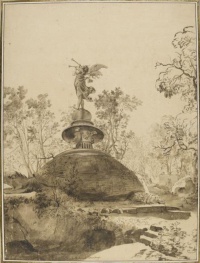Bomarzo
From The Art and Popular Culture Encyclopedia
(Difference between revisions)
| Revision as of 11:22, 10 February 2008 Jahsonic (Talk | contribs) ← Previous diff |
Current revision Jahsonic (Talk | contribs) |
||
| Line 1: | Line 1: | ||
| + | [[Image:Bomarzo turtle by Bartholomeus Breenbergh.jpg|thumb|200px|Turtle from the ''[[Gardens of Bomarzo]]'' by Bartholomeus Breenbergh]] | ||
| {{Template}} | {{Template}} | ||
| - | '''Bomarzo''' is a town and [[comune]] located at 68 kilometers from [[Rome]] known for its [[folly]], the park of monsters. | + | '''Bomarzo''' is a [[town]] located at 68 kilometers from [[Rome]] known for its [[Gardens of Bomarzo]]. |
| - | ==Park of the Monsters== | + | [[Bomarzo]]'s main attraction is a [[garden]] usually referred to as the ''Bosco Sacro'' ([[Sacred grove]]) or, locally, ''[[Bosco dei Mostri]]'' ("Monsters' Grove"), named for the many larger-than-life sculptures, some sculpted in the bedrock, which populate this predominantly barren landscape. |
| - | Bomarzo's main attraction is a [[garden]] usually referred to as the ''Bosco Sacro'' ([[Sacred grove]]) or, locally, ''Bosco dei Mostri'' ("Monsters' Grove"), named for the many larger-than-life sculptures, some sculpted in the bedrock, which populate this predominantly barren landscape. | + | |
| - | + | ||
| - | It is the work of [[Pier Francesco Orsini]], called ''Vicino'' (1528–1588), a hunchback [[condottiero]] and patron of the arts, greatly devoted to his wife [[Giulia Farnese (Latera)|Giulia Farnese]] (daughter of Galeazzo Farnese Duke of Latera, not to be confused with [[Giulia Farnese]]); when she died, he created the gardens. The design that has been attributed to [[Pirro Ligorio]], a well known architect of the time. | + | |
| - | + | ||
| - | The park of Bomarzo was intended not to please, but to astonish, and like many [[Mannerism|Mannerist]] works of art, its symbolism is arcane: examples are a large sculpture of one of [[Hannibal]]'s [[war elephant]]s, which mangles a [[Roman legion]]ary, or the statue of [[Ceres (mythology)|Ceres]] lounging on the bare ground, with a vase of verdure perched on her head. | + | |
| - | + | ||
| - | The many monstrous statues appear to be unconnected to any rational plan and appear to have been strewn almost randomly about the area, ''sol per sfogare il Core'' ("just to set the heart free") as one inscription in the obelisks says. | + | |
| - | + | ||
| - | Allusive verses in Italian by [[Annibal Caro]], [[Bitussi]] and [[Cardinal Modruzzo]], some of them now eroded, were inscribed besides sculptures. | + | |
| - | + | ||
| - | The reason for the layout and design of the garden is largely unknown: perhaps they were meant as a foil to the perfect symmetry and layout of the great [[Renaissance]] gardens nearby at [[Villa Farnese]] and [[Villa Lante]]. Next to a formal exedra is a tilting watchtowerlike [[Casina (architecture)|casina]], the so-called ''Casa Storta'' ("Hanging House"). | + | |
| - | + | ||
| - | An octagonal templet was added about twenty years later to honor the second wife of Orsini, Giulia Farnese. | + | |
| - | + | ||
| - | During the nineteenth century and deep into the twentieth the garden became overgrown and neglected, but in the 1970s a program of restoration was implemented by the Bettini family, and today the garden, which remains private property, is a major tourist attraction. | + | |
| - | + | ||
| - | The [[Surrealism|surreal]] nature of the Parco dei Mostri appealed to [[Jean Cocteau]] and the great surrealist [[Salvador Dalí]], who discussed it at great length. The poet [[André Pieyre de Mandiargues]] wrote an essay devoted to Bomarzo. [[Niki de Saint Phalle]] was inspired by Bomarzo for her ''Tarot Garden''. The story behind Bomarzo and the life of Pier Francesco Orsini are the subject of a fascinating novel by the Argentinian writer [[Manuel Mujica Láinez]] (1910-1984), ''Bomarzo'' (1962). Mujica Láinez himself wrote a libretto based on his novel, which was set to music by [[Alberto Ginastera]] (1967). The opera ''Bomarzo'' premièred in Washington in 1967. In Argentina the opera was banned by the military dictatorship, but in the USA both Mujica Láinez and Ginastera were awarded the Pulitzer Prize. | + | |
| {{GFDL}} | {{GFDL}} | ||
Current revision

Turtle from the Gardens of Bomarzo by Bartholomeus Breenbergh
|
Related e |
|
Featured: |
Bomarzo is a town located at 68 kilometers from Rome known for its Gardens of Bomarzo.
Bomarzo's main attraction is a garden usually referred to as the Bosco Sacro (Sacred grove) or, locally, Bosco dei Mostri ("Monsters' Grove"), named for the many larger-than-life sculptures, some sculpted in the bedrock, which populate this predominantly barren landscape.
Unless indicated otherwise, the text in this article is either based on Wikipedia article "Bomarzo" or another language Wikipedia page thereof used under the terms of the GNU Free Documentation License; or on research by Jahsonic and friends. See Art and Popular Culture's copyright notice.

